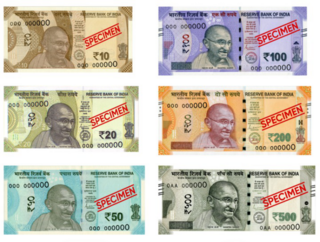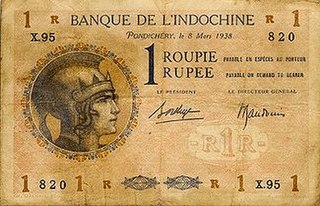Related Research Articles

Rupee is the common name for the currencies of India, Mauritius, Nepal, Pakistan, Seychelles, and Sri Lanka, and of former currencies of Afghanistan, Bahrain, Kuwait, Oman, the United Arab Emirates, British East Africa, Burma, German East Africa, and Tibet. In Indonesia and the Maldives, the unit of currency is known as rupiah and rufiyaa respectively, cognates of the word rupee.

The Indian rupee is the official currency in India. The rupee is subdivided into 100 paise. The issuance of the currency is controlled by the Reserve Bank of India. The Reserve Bank manages currency in India and derives its role in currency management based on the Reserve Bank of India Act, 1934.

The Pakistani rupee is the official currency in the Islamic Republic of Pakistan. The issuance of the currency is controlled by the State Bank of Pakistan. It was officially adopted by the Government of Pakistan in 1949. Earlier the coins and notes were issued and controlled by the Reserve Bank of India until 1949, when it was handed over to the Government and State Bank of Pakistan, by the Government and Reserve Bank of India.

The Coinage of India began anywhere between early 1st millennium BCE to the 6th century BCE, and consisted mainly of copper and silver coins in its initial stage. The coins of this period were Karshapanas or Pana. A variety of earliest Indian coins, however, unlike those circulated in West Asia, were stamped bars of metal, suggesting that the innovation of stamped currency was added to a pre-existing form of token currency which had already been present in the Janapadas and Mahajanapada kingdoms of the Early historic India. The kingdoms that minted their own coins included Gandhara, Kuntala, Kuru, Magadha, Panchala, Shakya, Surasena, Surashtra and Vidarbha etc.

Coins of the Indian rupee (₹) were first minted in 1950. New coins have been produced annually since then and they make up a valuable aspect of the Indian currency system. Today, circulating coins exist in denominations of One Rupee, Two Rupees, Five Rupees, Ten Rupees and Twenty Rupees. All of these are produced by four mints located across India, in Kolkata, Mumbai, Hyderabad, Noida.

The economy of India is a developing mixed economy with a notable public sector in strategic sectors. It is the world's fifth-largest economy by nominal GDP and the third-largest by purchasing power parity (PPP); on a per capita income basis, India ranked 136th by GDP (nominal) and 125th by GDP (PPP). From independence in 1947 until 1991, successive governments followed the Soviet model and promoted protectionist economic policies, with extensive Sovietization, state intervention, demand-side economics, natural resources, bureaucrat driven enterprises and economic regulation. This is characterised as dirigism, in the form of the Licence Raj. The end of the Cold War and an acute balance of payments crisis in 1991 led to the adoption of a broad economic liberalisation in India and indicative planning. Since the start of the 21st century, annual average GDP growth has been 6% to 7%., India has about 1,900 public sector companies, Indian state has complete control and ownership of railways, highways; majority control and stake in banking, insurance, farming, dairy, fertilizers & chemicals, airports, nuclear, mining, digitization, defense, steel, rare earths, water, electricity, oil and gas industries and power plants, and has substantial control over digitalization, Broadband as national infrastructure, telecommunication, supercomputing, space, port and shipping industries, among other industries, were effectively nationalised in the mid-1950s.

The roupie or rupee was the currency of French India. It was equal to the Indian rupee issued by the Indian government. One rupee was worth 2.40 francs-or. Until 1871 it was issued as coins with the roupie divided into 8 fanons, each of 3 doudous or 20 cash. From 1891, banknotes were issued by the Banque de l'Indochine, which circulated alongside coins issued by British India.

The history of the rupee traces back to ancient times in the Indian subcontinent. The mention of rūpya by Pāṇini is seemingly the earliest reference in a text about coins. The term in Indian subcontinent was used for referring to a coin.
The rupee was the currency of Burma between 1852 and 1952, except for the years 1943–1945.

Danish India was the name given to the forts and factories of Denmark in the Indian subcontinent, forming part of the Danish overseas colonies. Denmark–Norway held colonial possessions in India for more than 200 years, including the town of Tharangambadi in present-day Tamil Nadu state, Serampore in present-day West Bengal, and the Nicobar Islands, currently part of India's union territory of the Andaman and Nicobar Islands. The Danish and Norwegian presence in India was of little significance to the major European powers as they presented neither a military nor a mercantile threat. Dano-Norwegian ventures in India, as elsewhere, were typically undercapitalized and never able to dominate or monopolize trade routes in the same way that British, French, and Portuguese ventures could.

The Travancore rupee was a type of currency issued by the erstwhile Indian princely state of Travancore, which was primarily located in the modern Indian state of Kerala. The rupee was largely a newer currency in comparison to the older currencies of Kerala such as the Fanams, Achus, Chuckrams as well as the Kasu. Its creation was probably intended for the increased trading with British India and the high-value transactions therein.

The fanam was a currency issued by the Madras Presidency until 1815. It circulated alongside the Indian rupee, also issued by the Presidency. The fanam was a small silver coin, subdivided into 80 copper cash, with the gold pagoda worth 42 fanams. The rupee was worth 12 fanams. After 1815, only coins of the rupee currency system were issued.

The British Raj was the rule of the British Crown on the Indian subcontinent, lasting from 1858 to 1947. It is also called Crown rule in India, or Direct rule in India. The region under British control was commonly called India in contemporaneous usage and included areas directly administered by the United Kingdom, which were collectively called British India, and areas ruled by indigenous rulers, but under British paramountcy, called the princely states. The region was sometimes called the Indian Empire, though not officially.

The Kalka–Shimla Railway is a 2 ft 6 in narrow-gauge railway in North India which traverses a mostly mountainous route from Kalka to Shimla. It is known for dramatic views of the hills and surrounding villages. The railway was built under the direction of Herbert Septimus Harington between 1898 and 1903 to connect Shimla, the summer capital of India during the British Raj, with the rest of the Indian rail system.
The Indian indenture system was a system of indentured servitude, by which more than 1.6 million workers from British India were transported to labour in European colonies, as a substitute for slave labor, following the abolition of the trade in the early 19th century. The system expanded after the abolition of slavery in the British Empire in 1833, in the French colonies in 1848, and in the Dutch Empire in 1863. British Indian indentureship lasted till the 1920s. This resulted in the development of a large South Asian diaspora in the Caribbean, Natal, East Africa, Réunion, Mauritius, Sri Lanka, Malaysia, Myanmar, and Fiji, as well as the growth of Indo-Caribbean, Indo-African, Indo-Mauritian, Indo-Fijian, Indo-Sri Lankan, Indo-Malaysian, and Indo-Singaporean populations.

Dhunachi is a Bengali incense burner used for one of the stages during arti. It is often used following the arti with the pradip.

Patiala State was a kingdom and princely state in British India, and one of the Phulkian States, that acceded to the Union of India upon Indian independence and partition in 1947. The state was founded by Ala Singh in 1762. Patiala State was the largest and most important princely state in the Punjab Province. The state's ruler, the Maharaja of Patiala, was entitled to a 17-gun salute and held precedence over all other princes in the Punjab Province during the British Raj. The state was ruled by Jat Sikhs of the Sidhu gotra (clan).

Coinage under British governance of the Indian subcontinent can be divided into two periods: East India Company (EIC) issues, pre-1835; and Imperial issues struck under direct authority of the crown. The EIC issues can be further subdivided into two subcategories: the Presidency issues, which comprise separate Madras Presidency, Bombay Presidency, and Bengal Presidency issues; and uniform coinage for all British territories from 1835 to 1858. Imperial issues bear obverse portraits of Queen Victoria, Edward VII, George V, and George VI. No British India coins were issued during the brief reign of Edward VIII.
The Indian paisa is a 1⁄100 (one-hundredth) subdivision of the Indian rupee. The paisa was first introduced on 1 April 1957 after decimalisation of the Indian rupee.

The Indian 1-rupee coin (₹1) is an Indian coin worth one Indian rupee and is made up of a hundred paisas. Currently, one rupee coin is the smallest Indian coin in circulation. Since 1992, one Indian rupee coins are minted from stainless steel. Round in shape, the one rupee coins weighs 3.76 grams, has a diameter of 21.93-millimetre (0.863 in) and thickness of 1.45-millimetre (0.057 in). In independent India, one rupee coins was first minted in 1950 and is currently in circulation.
References
- ↑ Chaudhuri, R.R. (2018). Central Bank Independence, Regulations, and Monetary Policy: From Germany and Greece to China and the United States. Palgrave Macmillan US. p. 173. ISBN 978-1-137-58912-5 . Retrieved 2 November 2024.
... Danish Indian rupee, which was divided into 8 fano, each of which was further divided into 80 kas (or cash).
- ↑ Encyclopedia Indica: A Compendium of Milestones. Pelican Creations International. 2006. p. 372. ISBN 978-81-86738-14-6 . Retrieved 2 November 2024.
The Indian rupee replaced the Danish Indian rupee in 1845, the French Indian rupee in 1954 and the Portuguese Indian escudo in 1961.